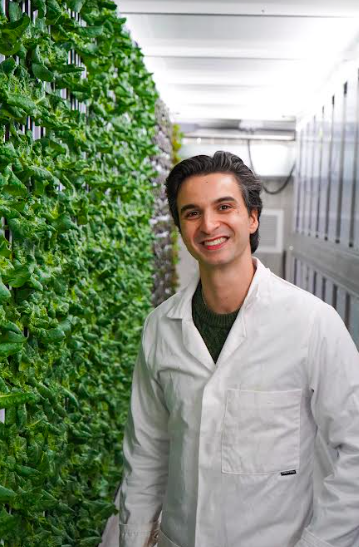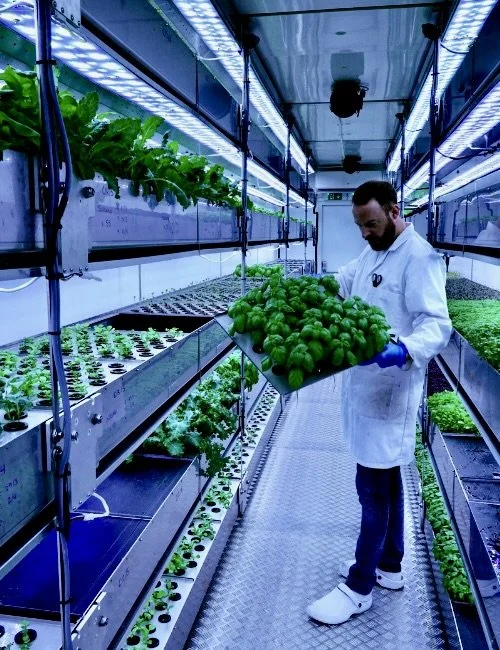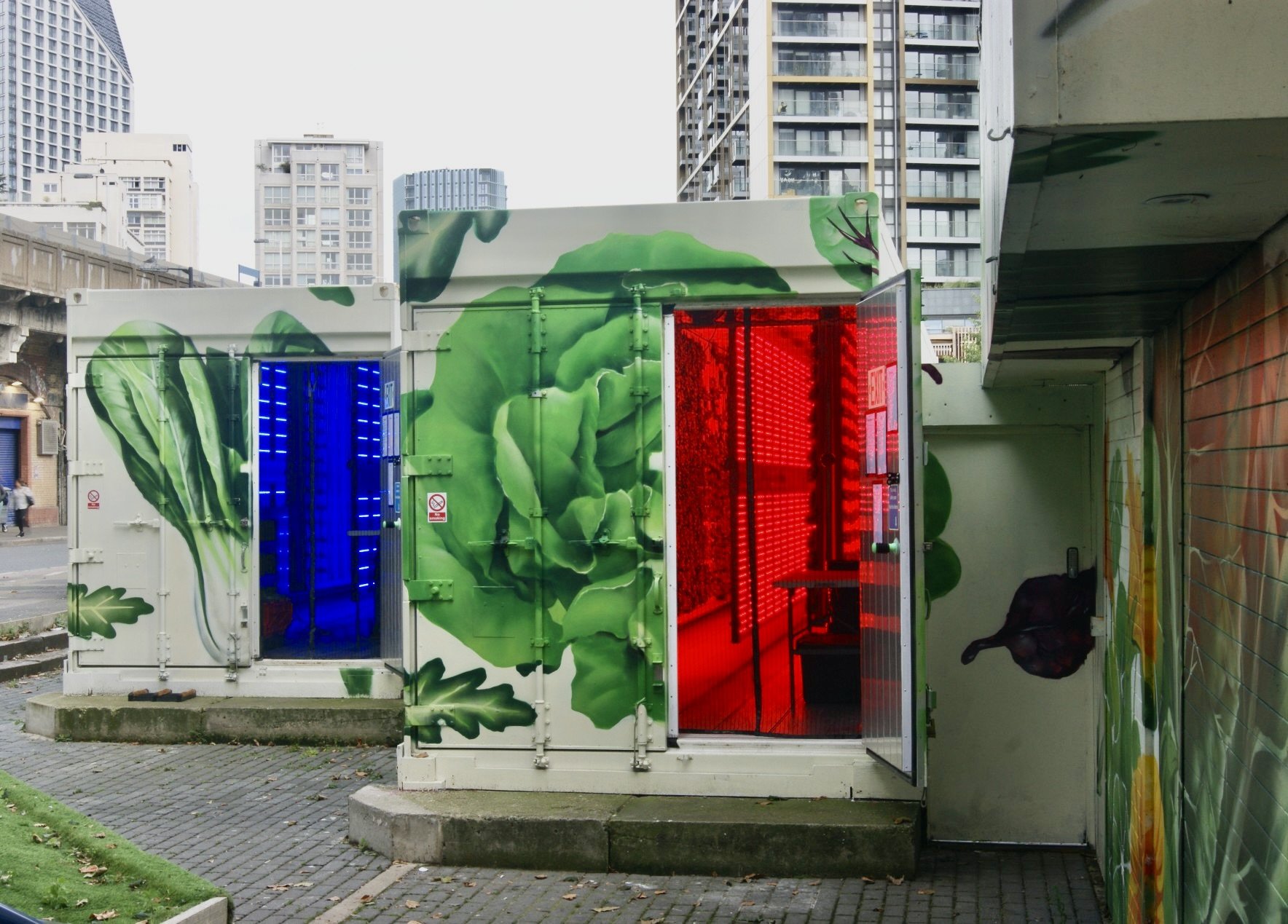United Kingdom: Brands To Buycott - Crate To Plate
Words by Christina Dean
Repurposing shipping containers is nothing new in London – we’ve got mini-malls and food courts in Boxpark and offices in Containerville – and now with Crate to Plate, farms can be added to that list.
Yes there are containers scattered across the city, in places like Canary Wharf, Stratford and Elephant & Castle, that are growing kilos and kilos of fresh leafy greens, all year round, using hydroponic and aeroponic farming technology. As CEO Daniel Trisato explains, Crate to Plate “grows this produce locally, in a controlled environment so we can do it year-round. We can supply a consistent, high-quality product without any effects of seasonality or any of the other challenges that come from traditional agriculture, all grown with zero use of pesticides and toxic chemicals, and supplied to the customer within 24 hours of harvest, so you get the freshest, most nutritious, tastiest version of whatever is you’re buying from us.”
The UK imports upwards of 70% of its fresh produce, which means before you see salad leaves in front of you, they’ve been travelling many miles through a long supply chain, for potentially a week, maybe even ten days. That, as Daniel explains, “leads to very short shelf lives, worse flavour and aroma profiles, whether it’s a lettuce head or a basil leaf, but also much lower nutritional value because these plants are losing nutrient density with pretty much each day after they’re cut from the root.” That’s the system that Crate to Plate is working to change, particularly somewhere like London where both consumption and imports are high. Given that the mission is to serve customers – that’s the public, restaurants and grocery stores – locally, within about a 30-minute drive, the container farms are deliberately placed in densely populated, urban areas.
“We want to be a commercially viable farming operation, not some tech gimmick. This has to be a legitimate alternative to current food supply chains”
These are farms of the future, where technology is used to optimise every stage of the growing process. The plants start in a seeding area, which has its own watering and lighting systems, for two to three weeks, and once they reach seedling stage, they’re transplanted into the “field”, aka hydroponic panels to finish growing. Everything is highly controlled, from the precisely balanced nutrient mixes and pH of the water to the lighting schedules, temperature and humidity, and it can all be monitored and adjusted remotely.
Some of the Crate to Plate farms use hydroponic technology, where the plants are grown vertically, without the use of soil, with nutrient-rich water circulated around the panels and dripped down on the roots of the plants (any extra is collected in troughs at the bottom and recirculated). This method of growing uses around 95% less water than traditional agriculture, as it’s specifically targeted at the root and has no run-off into the soil. Other farms use aeroponic technology, which again involves no soil and a horizontal, rather than vertical stack of plants (microgreens and herbs like garlic chives and coriander grow well in this system) with the water misted onto the root from below. This is even more efficient, using up to 99% less water than traditional growing methods. And this tech-led approach is getting results; each container can produce upwards of 40 kilos of lettuce a week. As Daniel says, “we want to be a commercially viable farming operation, not some tech gimmick. This has to be a legitimate alternative to current food supply chains otherwise it’s never gonna proliferate in a meaningful way.”
The growth cycle of microgreens from seed to harvest is around ten days whereas it’s about seven weeks for a lettuce, and the farms are planted in such a way that there’s always something ready for harvest, which happens about two or three times a week. Maintaining that level of consistency is what sets Crate to Plate apart from traditional farming, where harvests are less frequent and are at the mercy of the elements – Daniel points out that in the last six years, there have been three years of badly damaged lettuce harvests, two caused by heatwaves and one from heavy rain. This method also means that Crate to Plate can offer products that aren’t typically easy to come by in the UK, because on top of controlling and optimising the growing conditions, they can select varieties purely for flavour, whereas when you’re growing in a field, you have to select for things like resilience to weather and disease as well taste.
“It’s an alternative that’s gonna last really well in your fridge, it tastes better, it’s better for you and it’s also sustainably grown”
The core Crate to Plate product line is based on items “that we know are very good, they taste good, people like them and there’s demand for them, but also they grow well and we get good yields in the systems we have”. Their bestsellers include lettuce, rocket, basil (it can be temperamental to store and often takes a beating when transported through a traditional supply chain) and kale (they can achieve a tender leaf as well as good flavour and nutritional value). There is some space left in the farms for R&D, which is done both on the initiative of the farmers and from chef requests, and through that, they’ve been able to introduce ingredients like Mexican marigold to their product offering. It’s an aspect of the business that Daniel is particularly proud of, “if you’ve got something you like us to try, we’ll trial it”.
Establishing direct relationships with chefs is important to Crate to Plate because “this is still a fairly nascent industry and people don’t have a high level of familiarity with controlled environment agriculture, and that’s why we go in and sell direct. Once we put it in front of people and they actually taste our product, that’s what clinches the sale when you sit with a chef,” explains Daniel. “People think, ‘is it somehow artificial?’, ‘does it gather all the taste and nutrients that you get from the soil?’, and the reality is more because you actually optimise it. You don’t have to contend with all the elements, disease, pests and whatever, and you don’t get product delivered that might have little bits of dirt and grit from the field, because it’s completely without soil. You get a clean product where the taste profile is as good as it can be.” Offering a better product, with a higher nutritional value and longer shelf life, with the consistency of supply is a no-brainer for a restaurant, and the sustainability aspect is just the cherry on top. Their partners, who include Fortnum & Mason, Harrods, Hide, Annabel’s, Apricity, and Gaucho would seem to agree.
The same goes for the grocery customers – local boutique stores like Panzer’s, Andreas, and Notting Hill Fish Shop – who want consistency and a quality of product that won’t go bad on their shelves straightaway. For the consumers who order online and get the produce delivered to their homes, “it’s an alternative that’s gonna last really well in your fridge, it tastes better, it’s better for you and it’s also sustainably grown.”
With four container farming sites in London and three revenue streams, Crate to Plate has proven that the concept works, so now the goal is to scale. Daniel reveals that they’re underway with the set-up of a larger production facility in the city, with the same capacity as 50+ containers – not only will they be able to service a lot more volume, the operation will become even more efficient because they’ll be able to introduce a lot more automation. That’s expected to come online at the end of this year, with a couple more container sites being installed in the meantime. Beyond that? Expansion into other urban centres across the UK, so expect to see Crate to Plate farms coming to another city near you.






